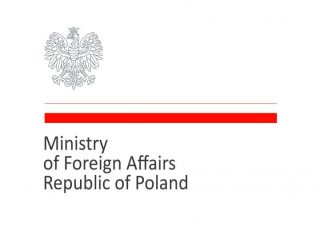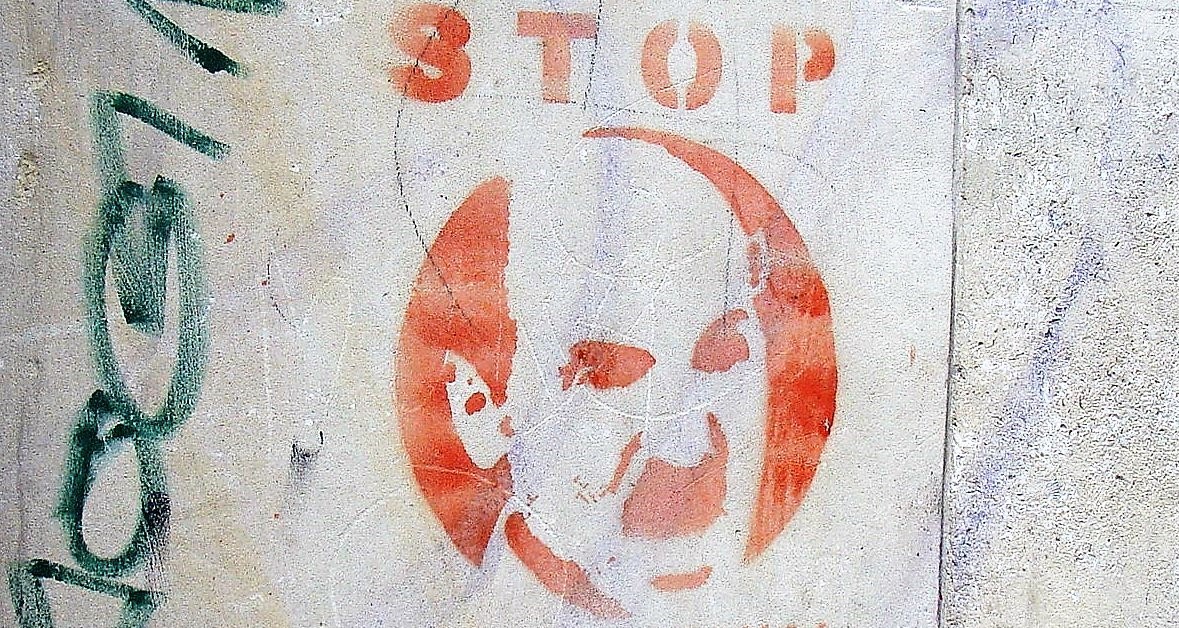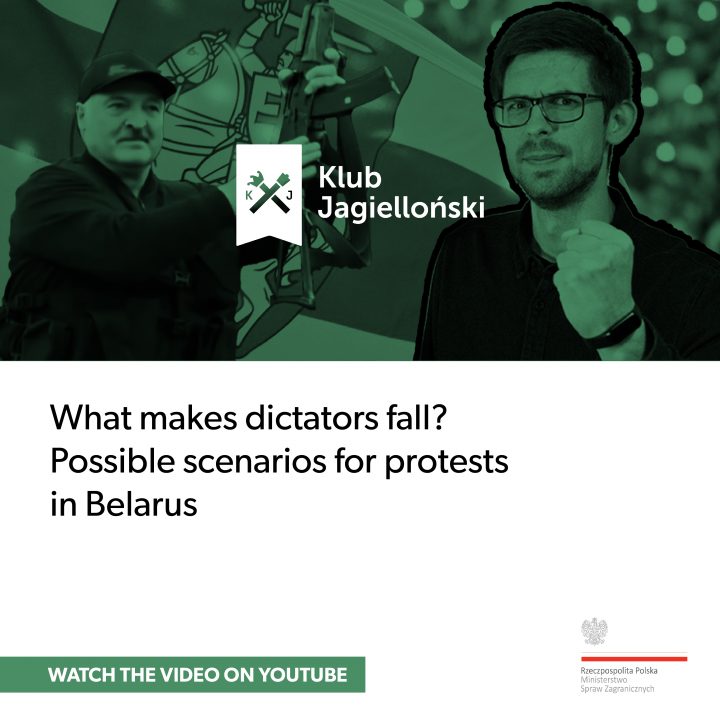The beginning of the end for Lukashenko?
W skrócie
The wave of protests that are currently rolling through Belarus is an unprecedented event in the country’s history. Even though strikes have been initiated on numerous occasions before, they have never grown to such a scale before. Not only are intellectuals rebelling, but so are employees of television and middle-level administration.
Despite the regime’s best efforts to restore ‘peace’, another week of protests in Belarus is on the rise. Today, there are no illusions that public support for Lukashenko is at an all-time low. The authorities’ actions spurred the formation of the foundations of civil society in Belarus. The climax was the rigged presidential elections, but to understand the situation one needs to look at the wider picture.
How Lukashenko lost social obedience
Belarus is in a dire economic situation. Even before the pandemic, a considerable decline in the country’s GDP was recorded. The downward trend was exacerbated by the economic crisis caused by COVID-19. Although the regime tried to ignore the pandemic, due to the country’s dependence on exports (nearly 50%) and Russian subsidies (Russian oil accounts for around 80% of Belarus’s demand), it was hit by the ongoing crisis particularly hard.
As a consequence, the recession of the economy in the first half of this year was 1.7%, and preliminary estimates predict a decline of up to 4%, which would be the highest pace of regression in 25 years. The recession is also deepened by the outdated economic model in which 60% of industrial production is owned by the state. Reforms have been proposed several times, by the former prime minister, the minister of the economy, and world-renowned economists. Actions to modernise the Belarusian economy are being hampered by the president, who fears social discontent and therefore sees reforms as a threat to his power.
The lack of the necessary changes and the backwardness of the economy, with an average salary of $200–300, had already caused dislike of Lukashenko. The president’s authority was additionally undermined by a contemptuous approach to the pandemic threat. The lack of restrictions and even negation of the threat allowed the virus to spread extremely quickly; more importantly, it also affected members of the elite and their children. Combined with the inefficient health care system, in 2020 the myth of Lukashenko as a guarantor of good social conditions and health care has quickly eroded.
Click the image below to watch the video: 'Belarus: Lukashenko vs the nation. Is this the end of the last European dictator? How do the dictators fall?’. English subtitles are available!
Dirty fight for re-election
To be clear: the uniqueness of the last election does not lie in the manipulation of election results. Election fraud is a common practice in Belarus, also raising objections in previous years. For example, after the 2010 elections, 40,000 people took part in demonstrations in Minsk. However, they did not spread across the whole country.
The previous demonstrations focused primarily on well-known opposition activists, which is why the brutality with which they were answered did not arouse such outrage among citizens. The security forces acted on the principle of intimidation: the stronger the authorities’ response, the less likely the opposition were to win supporters. This time, however, Lukashenko has gone too far. Ordinary people were being beaten in the street, not an organised opposition. This led to dissatisfaction with the president.
Along with another election, several mechanisms were created, which (at least in the official version) are meant to secure the election process, though in practice they neutralise the opposing candidates. In reality, the system has flawlessly adjusted to eliminate potential threats, including blocking certain candidates from running even at the stage of collecting signatures.
In this way, Valery Tsepkalo, who allegedly lacked several thousand signatures, was tossed out this year. Force is also sometimes used. In 2006, Alyaksandr Kazulin was arrested a month before the elections. 4 years later the situation repeated itself. It came as no surprise this year when a similar method was applied to Tsikhanouski and Babaryka—both were arrested, preventing them from starting their campaigns.
The second preventive measure was not related to political rivals, but to the election procedure itself: seats on electoral commissions were allocated top-down. The number of election observers, whose role is to be present on the premises and to monitor compliance with the rules, has also been restricted. Under the pretence of limiting the possibility of infection, the number of observers was reduced to five, while in previous years no maximum limit was specified. These seats were given to government employees—e.g. administrative clerks or teachers—whose jobs depend on the generosity of the regime.
Despite the ‘preventive measures’ and his experience at ‘winning’ the elections, Lukashenko made a mistake in disregarding the candidacy of Sviatlana Tsikhanouskaya. He did not expect that a woman, without any political support, could pose a threat (Andrzej Kohut wrote more about Lukashenko’s indulgent approach to the candidate on our website some time ago).
However, after the major candidates were arrested, the campaign staff of Tsepkalo and Babaryka united around an alternative candidate. Despite the fact that many commentators believe that Tsikhanouskaya is not charismatic and lacks political experience, she has become a symbol of the struggle for a democratic Belarus. Paradoxically, it was mainly the case because most candidates were blocked from running in the elections.
The weakening the regime?
Despite the initially harsh response from the authorities, the protests have spread across the country. The turning point was Sunday, 16 August, when 150,000–200,000 demonstrators gathered in Minsk alone, an unprecedented number in the history of Belarus. However, protests in the streets Lukashenko can tolerate. The real danger for him are riots in industrial plants.
It was there that the first protests appeared on 14 August. At first, they were started by plants located in the capital, but then they were joined by facilities from all over Belarus, such as one of the two Naftan refineries in Novopolotsk, Belkalija in Soligorsk, MTZ (a tractor manufacturer), and MZKT (a truck manufacturer).
The uniqueness of the workers’ protests lies in the fact that their demands are strictly political, not social. The main ones are still a recount of votes and the abandonment of violence in the streets. On Monday, 17 August, the workers began a strike due to the failure to meet their demands. On that day, Lukashenko visited one of the protesting industrial plants. He met with a harsh reaction from the employees, who, not letting him speak, chanted ‘Leave.’
The workers’ revolt is a clear signal to the authorities. It cannot be denied that Lukashenko has for many years been steadily building the myth that he is a defender of social rights, especially of workers’ rights. The president saw the workers as his core electorate, and a revolt from them would truly paralyse the Belarusian economy.
The workers were joined by state television, which suspended live broadcasting on the morning of 17 August. Journalists began mass resignations under the slogan ‘We want the truth.’ This should be seen as another obstacle for Lukashenko. There was no broadcast of the counter-demonstration, at which the president suggested the protesters were a threat to Belarus’s security. State television has so far been one of the main propaganda tools, and due to the resignations, it has struggled with staffing. There were also manifestations of disloyalty on the part of the state apparatus. Employees of diplomatic missions in Switzerland, Sweden, and Slovakia have expressed their support for the protesters.
However, the power of these events should not be overestimated. Even though there is a spillover of disobedience to other fields of the state’s functioning, in reality, they are still isolated cases. Any attempt to manifest an aversion to Lukashenko’s regime ends up with the loss of one’s job at best, and imprisonment at worst. Such a consequence of rebellion is enough to discourage people from joining the protesters.
In Belarus, where more than half of employed people work in the state sector, those who are dismissed for political reasons have serious difficulties in finding a job again. The reason for their dismissal is entered in the trudowa kniżka (workbook), which makes it difficult to find a new source of income. Dismissal from work comes with the loss of prospects for income, and basic needs cannot yet be covered by the opposition, which is starting to form its own structure and system of assistance.
Society versus Lukashenko
The protests that began in Belarus after the vote ended have been continuing uninterrupted for two weeks. Unlike the protests of previous years, these differ in scale because, in addition to hosting many more people, they have also spread to cities in other regions. Protesters are demanding fair elections, the release of political prisoners, and an investigation into the brutality of the security forces. Although the campaign in Belarus has come to an end, one cannot deny that the president’s struggle for power is only just beginning.
After several days of consternation, the authorities went on a counteroffensive. Counter-demonstrations in support of Lukashenko were organised in Gomel and Mogilev. More activity can also be observed from the security forces, which have secured the television and government buildings. After temporary staffing problems in television, state propaganda is back in the game. The strikes in industrial plants are also clearly weaker. The directors of facilities have started applying more pressure, threatening to dismiss workers, which has effectively discouraged protests. As a result, a general strike and high hopes of stopping the regime have become less likely.
Despite the fact that Lukashenko seems to be taking control of the state again, the protests in the streets continue. The president is struggling with the new civil society that is organising itself, with no clear leaders or action plan. Meanwhile, we can observe the beginning of the formation of the opposition. The Coordination Council for the Transfer of Power has been established. While earlier one could speak of a spontaneous social uprising, its potential can now be used to take power away from Lukashenko peacefully.
What can the Russians and the European Union do?
Asking for Moscow’s help in containing the protests was initially an unlikely scenario for the Belarusian regime. The Russian side wanted to weaken the president and increase Belarus’s dependence on its eastern neighbour. Admittedly, Vladimir Putin congratulated Lukashenko on winning the elections, but there was more menace than kindness.
So far, Russian aid has not been required, but it cannot be ruled out. The Kremlin does not want an anti-Russian president in Belarus, but it is much more concerned with the president being overthrown by a revolution. A scenario where the public defeats the regime and forces democratic elections would be a potential internal threat to Russia.
On the other hand, however, one must bear in mind that by supporting Lukashenko, Russia risks changing society’s mood towards itself. The protests in Belarus are not anti-Russian and it would be a mistake to liken them to the wave of demonstrations in Ukraine in 2014.
On the other hand, the European Union is doing little to change anything in Belarus. At an extraordinary meeting of the European Council, the pacification of the protests was criticised and the election results were not recognised. Even if the EU does not want to provoke Russia with its response, its rapprochement with Belarus is associated with military cooperation, and thus with the destabilisation of the region.
One cannot hide the lack of meaningful action on the part of Western countries. After a few verbal declarations and heartfelt words in favour of the protesters, both the EU and the vast majority of Western neighbours do not seem to think realistically about helping the Belarusian opposition.
Even if Lukashenko persists, much has changed
The protests in Belarus are indeed unprecedented. However, it should be remembered that Lukashenko has years of creating a state apparatus behind him, which (apart from a few cases) is obeying him unquestioningly. In the current situation, it is rather appropriate to create possible scenarios, and there are at least a few of them.
Artyom Shraibman, a Belarusian journalist, has suggested three future possibilities: the introduction of martial law, the initiation of a dialogue with the authorities modelled on the transformation of the 1980s in Poland, and the natural end of the protests. The second scenario seems to be the best solution for society, but the main obstacle is Lukashenko’s attitude. ‘For him, even the thought of sitting at the table with foreign puppets is humiliating. And the officials’ fear of offering him this option is even stronger,’ says Shraibman on Salidarnasć.org.
Nothing seems to indicate that the Belarusian president would consider opening a dialogue with the opposition, let alone handing over his power. Even if Lukashenko persists, it does not change the fact that he has lost his legitimacy for society. How can he rule without the support of the citizens? There is no doubt that he would present any opposition to his power as an interference by external forces. He will not only try to use propaganda but force as well, if necessary.
The process of removing Lukashenko from power may still take several years at least. This does not change the fact that Belarus is entering a new era. Lukashenko will not give up his power easily, and all we can do is hope for it to happen without bloodshed. The speed and nature of the transformation determine not only the quality of the opposition and the strength of the protests but also the support of Belarus’s Western neighbours. For now, we have to root for the Belarusians and hope an efficient civil society emerges in their country.
Polish version is available here.
 Publication (excluding figures and illustrations) is available under Creative Commons Attribution 4.0 International. Any use of the work is allowed, provided that the licensing information, about rights holders and about the contest "Public Diplomacy 2020 – new dimension" (below) is mentioned.
Publication (excluding figures and illustrations) is available under Creative Commons Attribution 4.0 International. Any use of the work is allowed, provided that the licensing information, about rights holders and about the contest "Public Diplomacy 2020 – new dimension" (below) is mentioned.
The publication co-financed by the Ministry of Foreign Affairs of the Republic of Poland as part of the public project "Public Diplomacy 2020 – new dimension" („Dyplomacja Publiczna 2020 – nowy wymiar”). This publication reflects the views of the author and is not an official stance of the Ministry of Foreign Affairs of the Republic of Poland.





